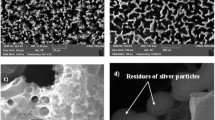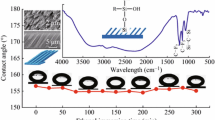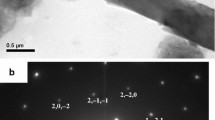Abstract
This paper reports on the extremely superhydrophobic behavior of supercritical CO2 processed silicon nanowires SiNWs) with a contact angle in excess of ∼177°. Vertically aligned silicon nanowires with 10 nm to 40 nm diameter and 1 mm to 3 mm in length were obtained by electroless etching (EE) technique. The asfabricated SiNWs were superhydrophilic with no water droplet formation (zero contact angle), and were then completely transformed to an extreme superhydrophobic state when their nanoscale surface roughness is combined with trichlorosilane hydrophobic coating. The processed SiNW array was so hydrophobic that water droplets always bounced off the surface and did not allow contact angle measurements to be obtained unless the substrate was intentionally given a concave-curvature by vacuum suction. Utilization of a hydrophobically surface-treated micro-pipette syringe enabled the release of a water droplet onto this extremely superhydrophobic surface for contact angle measurement. To prevent severe nanowire agglomeration during the drying process of wet etched SiNWs, supercritical CO2 drying was utilized, which process significantly improved the nano configuration and enhanced hydrophobicity.
Similar content being viewed by others
References
A. M. Morales and C. M. Lieber, Science 279, 208 (1998).
Y. Cui, L. J. Lauhon, M. S. Gudiksen, J. Wang, and C. M. Lieber, Appl. Phys. Lett. 78, 2214 (2001).
L. J. Lauhon, M. S. Gudiksen, C. L. Wang, and C. M. Lieber, Nature 420, 57 (2002).
N. Wang, Y. H. Tang, Y. F. Zhang, C. S. Lee, I. Bello, and S. T. Lee, Chem. Phys. Lett. 299, 237 (1999).
J. L. Gole, J. D. Stout, W. L. Rauch, and Z. L. Wang, Appl. Phys. Lett. 76, 2346 (2000).
J. D. Holmes, K. P. Johnston, R. C. Doty, and B. A. Korgel, Science 287, 1471 (2000).
K. Q. Peng, Y. J. Yan, S. P. Gao, and J. Zhu, Adv. Mater. 14, 1164 (2002).
K. Peng, Y. Wu, H. Fang, X. Zhong, Y. Xu, and J. Zhu, Angew. Chem. Int. Ed. 44, 2737 (2005).
H. Fang, Y. Wu, J. Zhao, and J. Zhu, Nanotechnology 17, 3768 (2006).
M. Nosonovsky and B. Bhushan, J. Phys.: Condens. Matter. 20, 225009 (2008).
A. Lafuma and D. Quere, Nat. Mater. 12, 457 (2003)
C. Neinhuis and W. Barthlott, Ann. Bot. 79, 667 (1997).
S. Herminghaus, Europhys. Lett. 52, 165 (2000).
N. Patankar, Langmuir 19, 1249 (2003).
K. K. S. Lau, Jos Bico, K. B. K. Teo, M. Chhowalla, G. A. J. Amaratunga, W. I. Milne, G. H. McKinley, and K. K. Gleason, Nano Lett. 3, 1701 (2003).
X. R. Ye, L. H. Chen, C. Wang, J. F. Aubuchon, I. C. Chen, A. I. Gapin, J. B. Talbot, and S. Jin, J. Phys. Chem. B 110, 12938 (2006).
Author information
Authors and Affiliations
Corresponding author
Rights and permissions
About this article
Cite this article
Choi, C., Yoon, Y., Hong, D. et al. Strongly superhydrophobic silicon nanowires by supercritical CO2 drying. Electron. Mater. Lett. 6, 59–64 (2010). https://doi.org/10.3365/eml.2010.06.059
Issue Date:
DOI: https://doi.org/10.3365/eml.2010.06.059




